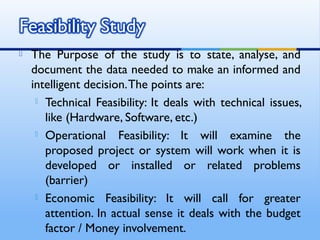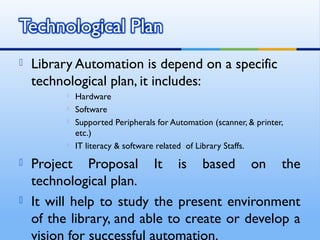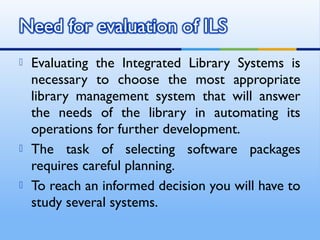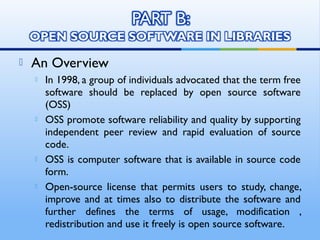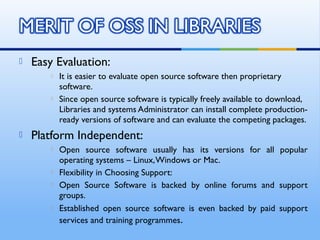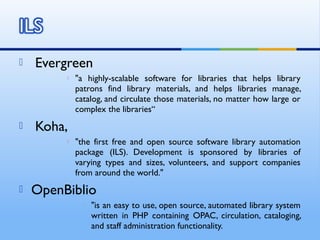LibraryLibrary Automation and Use of Open Source Software automation and use of open source software
- 1. OKIKI, O. Chris (Ph.D) Head, Automation Unit University of Lagos Library University of Lagos Akoka, Lagos chrisokiki2009@yahoo.com
- 2. Issues to Discussion : What is library automation Need for library automation Basic features & functions of Library Management System in a automated environment The role of standards in library automation and resource sharing A suitable design or plan for library automation Integrated library management system (Evaluation) Organise and implementation of effective strategy
- 3. Acquisition System Cataloguing System Circulation System Serial Control System OPAC Add-on Module
- 4. “ Library Automation” is a buzz word in the contemporary environment. It refers to the implementation of information and communications technologies (ICT) in the libraries & information centers. In other words, conversion of manual system into a specific MARC format which makes it suitable for cooperative networking and resource sharing among the libraries and information centers.
- 5. Increased operational efficiencies of the library staff. Improve the quality, speed, accuracy, and effectiveness of services. Get better access to other networks and systems, on the Web, etc. Facilitate wider access to information for their clients. Smooth the progress of wider dissemination of information products and services.
- 6. A library management system refers to the implementation of software, that has been developed to handle the basic housekeeping functions of a library. Single Function. Integrated Function Identifying the important role, that the library management system will play, in planning and implementing library automation projects. In this situation, it is necessary to educate ourselves through proper training and development.
- 7. Functional modules (as per requirement) Basic modules - acquisition, cataloging, circulation, & OPAC Add on modules - serial control, interlibrary loan (ILL), and Web OPAC, etc. Operating systems PreferablyWindows, Linux environment. Database systems Oracle, Informix, MS SQL, MS Access, etc… Network architecture Client-server architecture that uses TCP-IP to communicate across networks (LANs andWANs) User interface Graphical user interface (GUI), it is easier to work with and it allows a wide range of tasks to be accomplished with a click. Library automation standards A compatible standards such as MARC and Z39.50 protocol
- 8. The standards adopted by the library and its community that facilitate data interchange between libraries & information centers through a unique format which are supported by all systems, for example MARC (Machine Readable Cataloguing) standards and Z39.50, the information search and retrieve protocol standard. Why MARC The MARC standard allows libraries to share bibliographic resources with other information centers. It also enables libraries to easily migrate to commercially available library automation systems, a majority of which support only the MARC standard.
- 9. A bibliographic record in MARC format will allow the application system or library automation system to: Format the information correctly for printing a set of catalog cards or for displaying the information on computer screen Search for and retrieve certain types of information within specific fields (Keyword Searching) Display lists of items as required by the search . Z39.50 Protocol Z39.50 is generally defined as the information search and retrieve protocol standard used primarily by library and information related systems.
- 10. Cataloging activities using an Automated ILS, produces an electronic catalog. Providing access to the catalog for users which is limited to search and display, is called an “Online Public Access Catalog” or OPAC. An OPAC is usually offered as an add-on module that is inter- related with the cataloging module. The specific search and display features of an OPAC vary from system to system. OPAC can also be linked to the Circulation Module so that users can find out the status of any item (whether it is on loan, on-shelf, etc.), as well as making a self-reservation, self check-in/check-out, etc. Through the development in ICTs we can enable our libraries to publish their catalogs on the Web and making them accessible remotely, asWeb OPAC
- 11. Acquisitions Module Automates the acquisition process like : ordering, receiving, claiming material from vendors / suppliers, & also cancellations of library material at the time of order for purchase. Used to maintain statistics, and in some cases manage accounting activities. Acquisition can be done online if system is linked to an external network .
- 12. Creation, Storage, Retrieval and Management of bibliographic records and / or indexes. Defines the record in a specific format used in the database and provides for authority control (author, subject headings etc.) Usually there are two different interfaces for search and retrieval of the electronic catalog : For catalogers: that allows them to maintain the library database (main cataloging module) , For users: that allows them to search and display the results on (OPAC)
- 13. Handles circulation activities such as: lending, return, renewal, place on hold, and reservation etc. Manage library material - circulation type, location and status; patron database - patron type, profiles, privileges; and other transactions such as computation and payment of overdue fines, lost books, etc.
- 14. Steps Involved Engagement of Subject Expert Technology Plan Selection and Acquisition of ILMS Implementation Post-Analysis Engagement of Subject Expect Experienced guide is more essential initially, for the development of a new concept. It is necessary because “learn from the mistake” concept is their. The expert should be engaged from the beginning of the proposal for automation. In a automation system most important thing is the “staff literacy”, who will work from the start to implementation & take part in post-analysis.
- 15. Proposal In planning and implementing library automation, a thorough study of the library’s existing system as well as the library’s vision is necessary to enable the environment to prepare a good technology plan and project proposal. Steps: Vision Present Status Requirement Feasibility Study Technology Plan Project Proposal
- 16. A vision is a future dream. It is a vivid picture of what you would like your library to become in the near future. It is based on the mission of your library, the needs of our users and on the changing trends of library service. A vision provides direction and a philosophy for the library. Analysis of Present Status A systems study is conducted to assess the library’s status and needs. It involves gathering data about the library’s operations, capacity, facilities, collections, procedures, and staff expertise, etc. In general, the assessment should involve gathering information about user needs and wants and matching these with what the library can presently offer.
- 17. The Purpose of the study is to state, analyse, and document the data needed to make an informed and intelligent decision.The points are: Technical Feasibility: It deals with technical issues, like (Hardware, Software, etc.) Operational Feasibility: It will examine the proposed project or system will work when it is developed or installed or related problems (barrier) Economic Feasibility: It will call for greater attention. In actual sense it deals with the budget factor / Money involvement.
- 18. Library Automation is depend on a specific technological plan, it includes: Hardware Software Supported Peripherals for Automation (scanner, & printer, etc.) IT literacy & software related of Library Staffs. Project Proposal It is based on the technological plan. It will help to study the present environment of the library, and able to create or develop a vision for successful automation.
- 19. In House: The software developed by own or in by the institution / organisation. Commercial software: Software purchased from vendor. Out side from the organisation. For the selection of the best package for library, analyse and identify your needs and match it with the features and functions of integrated library systems.
- 20. Evaluating the Integrated Library Systems is necessary to choose the most appropriate library management system that will answer the needs of the library in automating its operations for further development. The task of selecting software packages requires careful planning. To reach an informed decision you will have to study several systems.
- 21. Engagement of subject expert Approval Submitting to vendor Receiving proposals from vendors Evaluating proposals Preparing a short list of vendors Requesting a demo of the system Purchasing the system Preparing the contract Proper training support Implementing the system Evaluating the implemented system
- 22. An Overview In 1998, a group of individuals advocated that the term free software should be replaced by open source software (OSS) OSS promote software reliability and quality by supporting independent peer review and rapid evaluation of source code. OSS is computer software that is available in source code form. Open-source license that permits users to study, change, improve and at times also to distribute the software and further defines the terms of usage, modification , redistribution and use it freely is open source software.
- 23. The following are OSS application: Integrated Library Management Systems Content Management System Digital Library Learning Management System E-publishing etc.
- 24. Open source software came into existence to fulfill the need of the Library shrinking budget Library Automation and Management is indeed for the library to maintain the records, Commercial automation software are too expensive and not bearable within the budget. Koha is the first open source integrated library system in the world.
- 25. Library is one of the main centre point to develop content management system to do it in a perfect manner OSS Content Management Software are DRUPAL and JOOMLA. Joomla is a award winning content management systems which enable library to build their own website with powerful online application.
- 26. Implementation of Digital library Software helps the user mainly in the retrieval of needed information such as faculty publication, Question papers, Newspaper clippings, Video Lecture and so on, this all together called as Institutional Repository. DSPACE is one of the widely used software Eprint etc
- 27. Easy Evaluation: It is easier to evaluate open source software then proprietary software. Since open source software is typically freely available to download, Libraries and systems Administrator can install complete production- ready versions of software and can evaluate the competing packages. Platform Independent: Open source software usually has its versions for all popular operating systems – Linux,Windows or Mac. Flexibility in Choosing Support: Open Source Software is backed by online forums and support groups. Established open source software is even backed by paid support services and training programmes.
- 28. No or less personal support: Less customer friendly ie, all the features expected by the user may not be available. Lack of training: Due to lack of training and expertise on OSS may lead to ineffective utilization of the software. Maintenance and trouble shooting OSS needs specialized skills and knowledge about that software. Need for technological sophistication Fewer advanced features Nobody is really responsible (by contract) OS may be incompatible with other deployed software
- 29. DIGITAL REPOSITORIES DSpace "is a turnkey institutional repository application." Greenstone "is a suite of software for building and distributing digital library collections. It provides a new way of organizing information and publishing it on the Internet or on CD-ROM.
- 30. Evergreen "a highly-scalable software for libraries that helps library patrons find library materials, and helps libraries manage, catalog, and circulate those materials, no matter how large or complex the libraries“ Koha, "the first free and open source software library automation package (ILS). Development is sponsored by libraries of varying types and sizes, volunteers, and support companies from around the world." OpenBiblio "is an easy to use, open source, automated library system written in PHP containing OPAC, circulation, cataloging, and staff administration functionality.
- 31. NewGenLib (NGL) is an outcome of collaboration between Verus and Kesavan. Institute has provided the domain expertise. It provides many basic ILS functions as well as having several social media functions buit in. SOPAC (Social Online Public Access Catalog) is a module for the Drupal CMS that provides true integration of your library catalog system with the power of the Drupal content management system
- 32. THANKS YOU

















